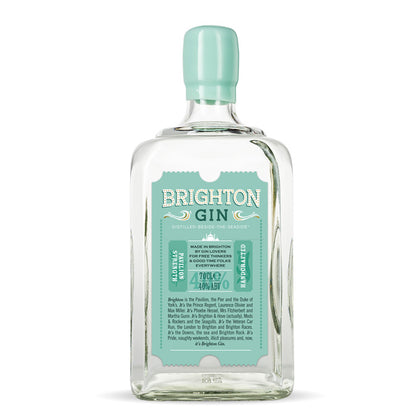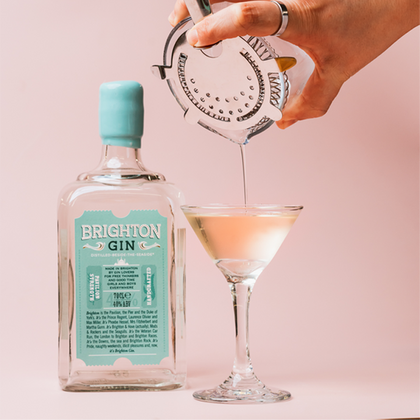What is Navy Strength Gin?
If you’ve ever sipped Brighton Gin’s Seaside Strength, resplendent with its navy-blue branding, then you have tasted navy strength gin - but what exactly is a navy gin? Make yourself a G&T and read on!
First of all, you may have noticed that it has a higher ABV than our Pavilion Strength, 57% compared to 40%. That is the definition of navy strength – the amount of alcohol. Pavilion and Seaside use the same ingredients, but in different amounts, and with very different production processes - our Seaside contains four times as much juniper, and twice the citrus, and spends a lot of time being rested in vessels along the way to really allow the flavours to rest, marry and blend.
Alcohol can act as a flavour enhancer and at higher percentages it bonds the most volatile scrumptious botanical aromatics that evaporate at lower ABVs. The much higher ABV holds all that amazing flavour in the Seaside and when rested over time marries them in a beautifully balanced gin that is ultra-smooth but packs a flavour punch.
Like all Brighton Gin, Seaside is made with 100% organic wheat spirit, which being distilled is gluten-free, and is certified vegan, including the waxed bottle tops and bottle label glue.
Brighton Gin is situated a pebble's throw from the sea so we absolutely had to have a navy strength in our range, and because we love our juniper & citrus led recipe so much we wanted to make a gin that could showcase those flavours in a different way to than our Pavilion does, and shows what you can achieve by using the same ingredients and different methods. It's also an absolutely perfect gin for cocktails, with waves of flavour coming through!
The History of Navy Gin
So what is navy strength gin history and what is the naval connection?
From the 18th century until 1970 the British ships carried spiritous liquors on-board – usually rum or gin. In the latter years this was for the crew to have a sociable tot, but originally it was there for multiple uses including for medicinal reasons, which sounds like an excuse but it’s true! For centuries, before analgesic drugs existed, spirits were used as pain relief because alcohol releases opioid endorphins in the brain. Alcoholic spirit was also essential for sterilising wounds, and equipment used in rudimentary on-board medical procedures. But there was another reason. An alcoholic drink is a treat and giving sailors a daily snifter was an effective method of managing their behaviour by rewarding them with a drinkie if they toed the line.
Navy strength’s high alcohol content was significant for two reasons. Before 1816 when the hydrometer was invented it was impossible to measure the true strength of a spirit. To avoid being swindled by unscrupulous distillers selling diluted goods, navy pursers (aka pussars), the ship’s accountants, tested the gin (or rum) by dousing a few grains of gunpowder and lighting it. If the gunpowder ignited this was proof that it was 100 % the required quality which equated to 57% alcohol by volume (ABV). There was a practical necessity for 100% proof spirit too because the casks it was packaged in might be stored near barrels of gunpowder and no-one could risk under-proof liquor spilling, soaking the powder and rendering it unusable.
Navy Gin Cocktails
Here at Brighton Gin we like to mix our Gimlets and Pink Gin using Seaside. Both those cocktails were born on the high seas and consequently would have been made with navy strength. In answer to the question of why cocktails were served on naval ships, it’s tempting to say why not, but the real reason is because they were just what the doctor ordered. Yes, the world’s first two gin cocktails were devised for medicinal purposes!
Distilled spirits were initially delivery methods for healing herbs and spices, not for recreational drinking, because the active ingredients dissolve in alcohol and are absorbed effectively by the body. The first written proof of the libation that evolved into gin came from mid-11th century Italian monks at a monastery in Salerno who documented their research on juniper berries in distilled wine. Juniper has been used for millennia to treat myriad health problems including gout, kidney and gastrointestinal infections, as well as having antiseptic properties.
PINK GIN
Pink gin contains rose-hued bitters made of plants such as gentian that over centuries have been used to treat a variety of ailments including stomach and digestive disorders. In 1824 a German physician, Gottlieb Siegart, based in the Venezuelan port of Angostura (now Ciudad Bolívar) developed a concoction of bitters that he marketed to visiting mariners as a treatment for seasickness. As the name suggests, they were intensely bitter, but adding a shot of gin made them easier to down in one.
GIMLET
And what about the Gimlet? Gin and lime juice – simple but so effective as a prophylactic against scurvy. Scurvy was the scourge of sailors who endured months at sea eating a monotonous diet of salted meat and ship’s biscuits with a distinct lack of fresh food. Scurvy is caused by vitamin C deficiency and symptoms include bleeding in joints and muscles, bleeding gums and lost teeth, reopening of previously healed wounds, and heart failure.
Left untreated it is a killer and was so deadly that it caused the death of hundreds of thousands of mariners over the years. Various remedies were trialled, then in 1795 the British Admiralty decreed that the most efficient antiscorbutic was citrus fruit. British sailors were issued with a compulsory daily dose of lemon or lime juice (hence the nickname ‘Limeys’) and it worked in preventing the dreaded disease.
Naturally, someone had the sensible idea of adding gin to the juice and in doing so invented the Gimlet, named either after Sir Thomas Gimlette, Surgeon General of the navy, or for the small metal tool used to drill a hole in the wooden barrel of lime juice. Sometimes less is more, and that is definitely the case with these two historic cocktails.
If you want to rustle up your own versions, grab a a bottle of Brighton Gin Seaside Strength Navy Gin and see below for a couple of ultra-simple Pink Gin and Gimlet recipes!
How to Make...

INGREDIENTS
60 ml Brighton Gin Seaside Strength Navy Gin
60ml freshly squeezed lime or lime cordial
Garnish with a lime wheel or sprig of thyme
METHOD
Drop ice cubes into a cocktail shaker or glass jar. Add the gin and lime juice/cordial and shake it for 10-15 seconds. Pour into the glass and garnish.
Glassware
Martini glass or coupe chilled in the fridge.










